Scientific name Desmostylia Higher classification Laurasiatheria | Phylum Chordata Rank Order | |
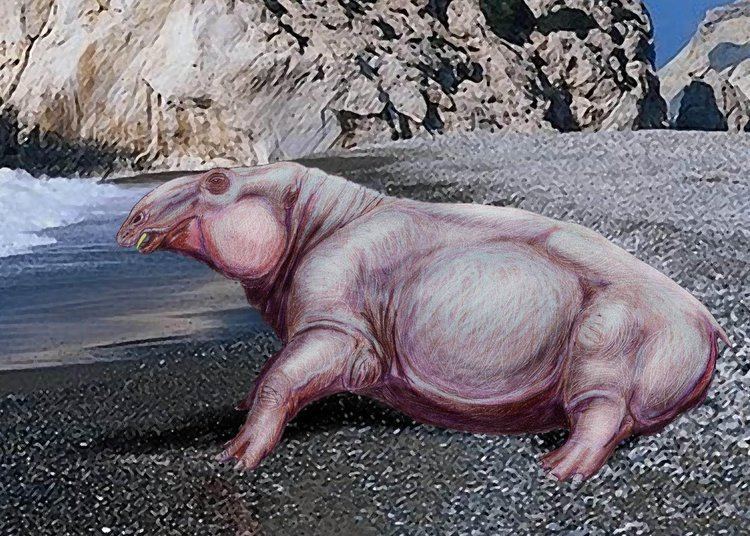 | ||
Similar | ||
Desmostylia (from Greek δεσμά desma, "bundle", and στῦλος stylos, "pillar") is an extinct order of aquatic mammals that existed from the late Oligocene (Arikareean) to the late Miocene (Tortonian) (30.8 to 7.25 million years ago).
Contents
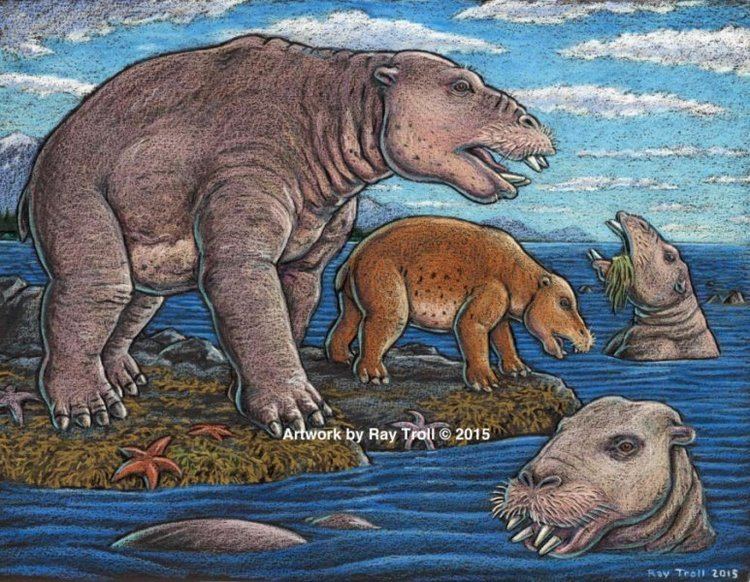
Desmostylians are the only known extinct order of marine mammals.
Desmostylia, together with Sirenia and Proboscidea (and possibly Embrithopoda), have traditionally been assigned to the afrotherian clade Tethytheria, a group named after the paleoocean Tethys around which they originally evolved. The relationship between Desmostylia and the other orders within Tethytheria has been disputed; if the common ancestor of all tethytheres was semiaquatic, the Proboscidea became secondarily terrestrial; alternatively, Desmostylia and Sirenia could have evolved independently into aquatic mammals. The assignment of Desmostylia to Afrotheria has always been problematic from a biogeographic standpoint, given that Africa was the locus of the early evolution of Afrotheria while Desmostylia has only been found along the Pacific Rim. That assignment has been seriously undermined by a 2014 cladistic analysis that places anthracobunids and desmostylians, two major groups of putative non-African afrotheres, close to each other within the laurasiatherian order Perissodactyla. However, a posterior study shows that, while anthracobunids are definite perissodactyls, desmostylians share the same amount of characters necessary for either Paenungulata or Perissodactyla, making their former assessment as afrotheres a possibility.

Description
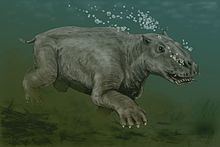
Desmostylians were large fully aquatic quadrupeds with massive limbs and a short tail. The smallest is Ashoroa laticosta, a relatively large animal at a body length of 168 centimeters, while the largest species reached sizes comparable to the Steller's Sea Cow.

A desmostylian skull has an elongated and broadened rostrum, with the nasal opening located slightly dorsally. The zygomatic arches are prominent (behind the eyes); the paroccipital processes elongated (downward-pointing processes behind the jaw-joints); and the epitympanic sinuses open into the temporal fossae (cavities above the ear holes).
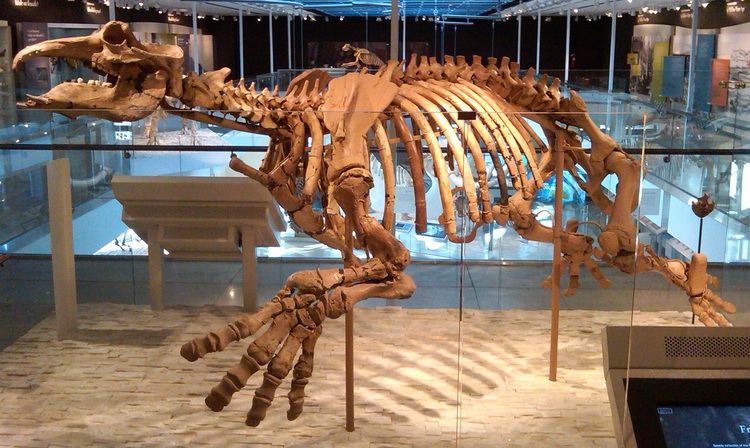
The mandible and maxilla typically have forward-pointing incisors and canine tusks, followed by a long postcanine diastema, partly because of the reduced number of premolars. The cusps of the premolars and molars are composed of densely packed cylinders of thick enamel, giving the order its name ("bundle of columns"). The primitive dental formula is 3.1.4.3, with a trilobate fourth deciduous premolar. The cheek teeth are brachydont and bunodont in primitive genera, but hypsodont in later genera such as Desmostylus, which has many supernumerary cusps.
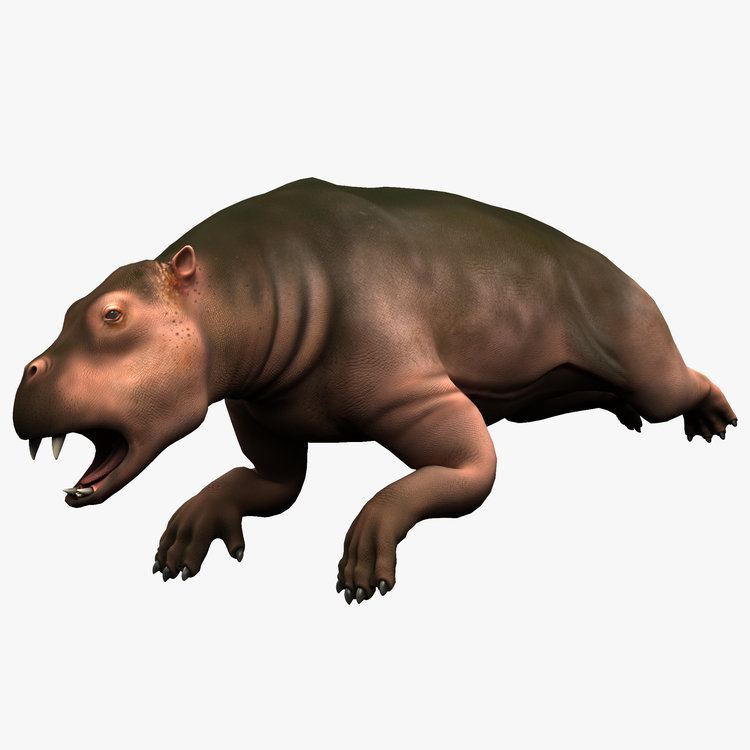
In the postcrania, the clavicle is absent and the sternum consists of a series of heavy, paired, plate-like sternebrae. In adults, the joints between the radius and ulna prevent any movements. The metacarpals are longer than metatarsals, and each foot has four digits (digit I is vestigial.)
Behaviour
Their dental and skeletal form suggests that desmostylians were aquatic herbivores dependent on littoral habitats. Their name refers to their highly distinctive molars, in which each cusp was modified into hollow columns, so that a typical molar would have resembled a cluster of pipes, or in the case of worn molars, volcanoes. (This may reflect the close relationship between the Paenungulata, to which this group has been assigned, and the Tubulidentata.)
Desmostylus does not chew or eat like any other known animal. It clenches its teeth, roots up plants with the help of tusks and powerful neck, and then sucks them in using strong throat muscles and the shape of the roof of the mouth.
Desmostylians are believed to aquatic because of a combination of characters. Their legs seemed to be adapted for terrestrial locomotion, while a number of other parameters confirms their aquatic nature:
Based on a comparison of trunk and limb proportions, Gingerich 2005 concluded that desmostylians were more terrestrial than aquatic and clearly forelimb dominated swimmers, hence they were more "sea bears" than "sea sloths" (as proposed by other researchers.) However, a more recent and detailed analysis of desmostylian bone structure has revealed them to be fully aquatic, like sirenians and cetaceans, with their limbs being incapable of supporting their own weight on land. More recent studies vindicate this assessment, as desmostylians had a thoraxic morphology more similar to sirenians and cetaceans than to that of semi-aquatic mammals.
Habitat
A 2017 study on Desmostylus and Paleoparadoxia shows that the former preferred areas shallower than 30 meters while the latter occurred in deep, offshore waters.
Distribution
Desmostylian fossils are known from the northern Pacific Rim, from southern Japan through Russia, the Aleutian Islands and the Pacific coast of North America to the southern tip of Baja California. They range from the Early Oligocene to the late Miocene.
Extinction
Desmostylians, being fully marine herbivores, are thought to have been outcompeted ecologically by dugongid sirenians. In particular, later species like Neoparadoxia are more specialised than previous forms, suggesting increased divergence in order to compete with sirenians, and sirenian diversity appears to increase with desmostylian decline. Both desmostylians and North Pacific dugongids were apparently kelp specialists, as opposed to marine herbivorous mammals from other regions, with diets primarily composed of seagrass.
Classification
The type species Desmostylus hesperus was originally classified from a few teeth and vertebrae as a sirenian by Marsh 1888, but doubts arose a decade later when more complete fossils were discovered in Japan. Osborn 1905 also proposed that they belonged to Sirenia. One of the most comprehensive collections of desmostylian teeth was amassed by paleontologist John C. Merriam, who concluded on the basis of the molar structure and repeated occurrence in marine beds that the animals had been aquatic, and were probably sirenian.
In 1926, the Austrian palaeontologist Othenio Abel suggested origins with monotremes, like the duck-billed platypus, and in 1933 he even created the order "Desmostyloidea", which he placed within Multituberculata. Abel died shortly after WW2 and his classification won few supporters and has been ignored since.
Because desmostylians were originally known only from skull fragments, teeth and bits of other bones, general agreement was that they had had flippers and a fin-like tail. The discovery of a complete skeleton from Sakhalin Island in 1941, however, showed that they possessed four legs, with bones as stout as a hippopotamus', and justified the creation of a new order for the desmostylians, described by Reinhart 1959.
A major find was announced in October 2015 after scientists examined an extensive group of giant, tusked, quadruped, marine mammal fossils. This northernmost to date species discovery had been unearthed during excavation for the construction of a school in Unalaska, in the Aleutian Islands. A rendition of a group was drawn by Alaskan artist Ray Troll.
Despite their similarities to manatees and elephants, desmostylians were entirely unlike any living creatures. Douglas Emlong's 1971 discovery of the new genus Behemotops from Oregon showed that early desmostylians had more proboscidean-like teeth and jaws than later ones. Despite this discovery, their relationships to manatees and proboscids remain unresolved. The analysis of Cooper et al. (2014) indicates the similarities with manatees and elephants may be a result of convergence and that they may instead be basal perissodactyls.
Barnes 2013 proposed a new classification of Paleoparadoxiidae:
